- Submissions

Full Text
Novel Research in Sciences
Urban Meat, Hidden Crisis: The Environmental and Health Footprint of Cameroon’s Industrial Abattoirs
Abel Tsolocto1*, Jean-Marie Fotsing2, Claude Codjia3 and Gratien Mavie Tchiadeu4
1University of TELUQ, Montreal, Canada
2University of New Caledonia, New Caledonia
3University of Quebec-Montreal, Canada
4University of Douala-Cameroon, Cameroon
*Corresponding author:Abel Tsolocto, University of TELUQ, Montreal, Canada
Submission: August 4, 2025;Published: August 20, 2025
.jpg)
Volume17 Issue 1August 20, 2025
Abstract
Rapid urban growth and industrial abattoir operations are transforming urban landscapes and posing significant public health risks in Cameroon. This study integrates four decades of satellite-derived Land Use/Land Cover (LULC) analysis, laboratory water quality assessments, and community surveys to evaluate environmental and health impacts around abattoirs in Douala and Yaoundé. Findings reveal that both sites experienced over 75% loss of green space alongside rapid expansion of built-up and agricultural land. Water quality consistently failed World Health Organization (WHO) standards, with coliform counts thousands of times above safe limits and all samples classified as “Very Poor” by the Water Quality Index. Community perceptions strongly align with these results, reporting widespread pollution and increased health concerns. This spatially explicit, mixed-methods approach demonstrates that unchecked urbanization and inadequate waste management create pollution hotspots and health risks. Coordinated policy enforcement, infrastructure investment, and community engagement are urgently needed. The framework developed offers a replicable model for sustainable urban environmental management in rapidly growing cities
Keywords: Urbanization; Land Use/Land Cover change; Water quality; Abattoirs; Public health; Cameroon; Environmental pollution; Mixed-methods
Introduction
Rapid urbanization and the intensification of industrial activities have significantly transformed urban landscapes across Sub-Saharan Africa, with profound implications for environmental quality and public health [1]. In Cameroon, the expansion of metropolitan centers such as Douala and Yaoundé has been accompanied by the proliferation of industrial abattoirs, which are frequently situated near densely populated neighborhoods and critical water bodies [2,3]. While abattoirs play a vital role in urban food supply chains, their operations generate substantial volumes of solid and liquid waste, often discharged untreated into the surrounding environment [4,5].
Recent studies have highlighted that this unchecked expansion and inadequate waste management have led to extensive Land Use/Land Cover (LULC) changes, including the conversion of green spaces and forests to built-up and agricultural areas, thereby reducing ecological buffers and increasing the vulnerability of urban ecosystems to pollution [3,4]. These transformations are particularly acute around major abattoir sites, where the loss of natural filtration capacity has been linked to the degradation of surface water quality and heightened risks of waterborne diseases [4,5].
Despite the existence of regulatory frameworks, enforcement remains weak, and community concerns about pollution and health risks are growing [2,4]. However, there remains a critical gap in integrated, site-specific research that combines spatial analysis of LULC change, laboratory-based water quality diagnostics, and community perceptions to comprehensively assess the environmental and health impacts of abattoir operations in Cameroon’s urban centers.
This study addresses this gap by conducting a multi-dimensional assessment of the Bonandale (Douala) and Etudi (Yaoundé) abattoir vicinities. Specifically, it analyzes four decades of LULC change using satellite imagery, evaluates water quality parameters relative to World Health Organization (WHO) standards, and examines community perceptions of environmental degradation and health risks. By triangulating these evidence streams, the research provides robust insights into the interplay between urban expansion, ecological loss, pollution, and public health--offering a foundation for targeted policy and infrastructure interventions.
Literature Review
The environmental and public health impacts of industrial abattoirs in rapidly urbanizing African cities have become a focal point of research over the past two decades. Early studies in Cameroon and comparable contexts established that abattoirs are significant sources of untreated solid and liquid waste, with direct consequences for local water bodies and urban ecosystems [1,4]. These impacts are compounded by weak regulatory enforcement and the proximity of abattoirs to densely populated neighborhoods and critical water sources.
Land Use/Land Cover (LULC) change and urban expansion
Urban expansion driven by population growth and economic development has led to extensive Land Use/Land Cover (LULC) changes in cities like Douala and Yaoundé. Research has documented the conversion of forest and green spaces to built-up and agricultural land, particularly in peri-urban zones surrounding industrial facilities such as abattoirs [1,2]. This transformation reduces ecological buffers, increases surface runoff, and heightens the vulnerability of water bodies to pollution. The loss of natural filtration capacity exacerbates the environmental footprint of abattoir operations, as observed in both satellite-based and field studies [3].
Water quality degradation
Multiple studies have reported that abattoir effluents, often discharged without adequate treatment, are major contributors to water pollution in urban environments. Laboratory analyses consistently show elevated levels of biochemical oxygen demand, Electrical Conductivity (EC), and fecal coliforms in streams and wells near abattoirs, frequently exceeding World Health Organization (WHO) standards [4]. These findings are particularly pronounced in areas where LULC change has diminished green space, further reducing the capacity of the environment to absorb and neutralize pollutants [3,4].
Community perceptions and health impacts
Community-based surveys and qualitative studies reveal strong local awareness of the environmental and health risks associated with abattoir operations. Residents living near abattoirs frequently report increased incidences of waterborne diseases, such as typhoid and gastroenteritis, and express concerns about poor hygiene and persistent standing water, which serve as breeding grounds for disease vectors [2,4,5]. These perceptions are corroborated by clinical data and microbiological analyses, highlighting the tangible health impacts of environmental degradation.
Regulatory and policy context
Although regulatory frameworks for abattoir waste management exist in Cameroon, enforcement remains inconsistent. Studies point to gaps in infrastructure, limited public awareness, and the prioritization of revenue collection over environmental compliance as persistent challenges [2,5]. The lack of effective governance not only perpetuates environmental risks but also undermines public trust and the efficacy of policy interventions.
Research gap
Despite growing recognition of these issues, there remains a critical gap in integrated, site-specific research that combines spatial analysis of LULC change, laboratory-based water quality diagnostics, and community perceptions to assess the full spectrum of environmental and health impacts of abattoir operations in urban Cameroon. Most existing studies focus on single dimensions--either environmental, health, or policy--without triangulating evidence streams for a holistic understanding.
Rationale for the present study
This study addresses the identified gap by conducting a multidimensional assessment of the Bonandale (Douala) and Etudi (Yaoundé) abattoir vicinities. By integrating four decades of LULC change analysis, comprehensive water quality evaluation, and community perception surveys, the research provides robust insights into the interplay between urban expansion, ecological loss, pollution, and public health. These findings are intended to inform targeted policy and infrastructure interventions for sustainable urban abattoir management.
Methods and Study Area
Study area
This research was conducted in the vicinities of the Bonandale abattoir in Douala (Littoral Region) and the Etudi abattoir in Yaoundé (Centre Region), Cameroon’s two largest and most rapidly urbanizing cities (Figure 1-8). Douala, situated along the Wouri River, serves as the nation’s economic capital and features dense residential settlements, expanding industrial zones, and critical aquatic ecosystems. The Bonandale abattoir is strategically located near both residential neighborhoods and major water bodies, exemplifying the interface between urban expansion and ecological vulnerability.
Fgure 1:Location map for Douala and Yaounde industrial abattoir areas.
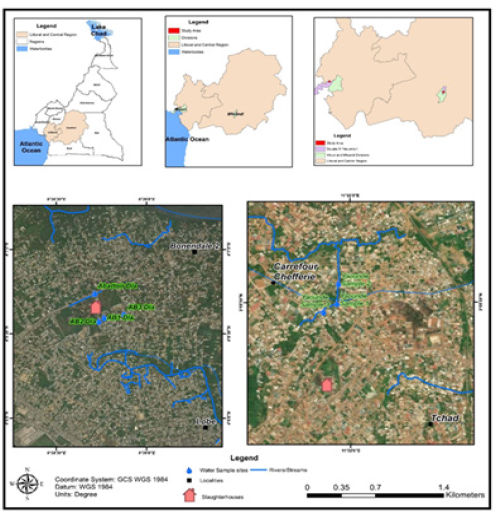
Fgure 2:Compréhensive Research Methodology for Abattoir Impact assessment.
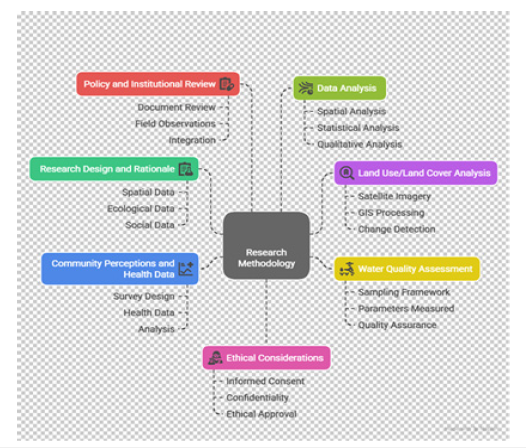
Fgure 3:Land Use/Land Cover in Yaoundé Abattoir Area, 1982. This map illustrates the predominance of green space and minimal urban development at the start of the study period.
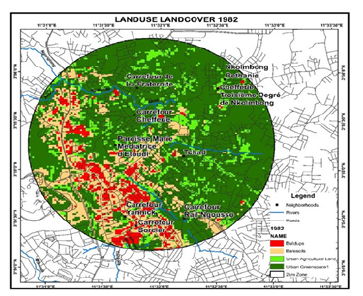
Fgure 4:Land Use/Land Cover in Yaoundé Abattoir Area, 2012. By 2012, the figure shows substantial expansion of built-up areas and urban agriculture, with a visible reduction in green cover.
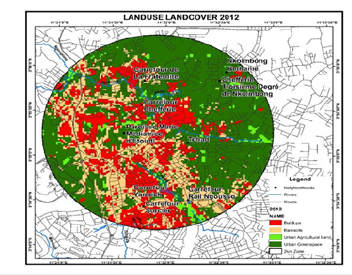
Fgure 5:Land Use/Land Cover in Yaoundé Abattoir Area, 2024. The 2024 map highlights the near-dominance of built-up and agricultural land, with green space now fragmented and sparse.
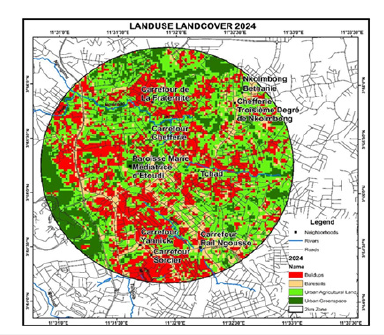
Fgure 6:Land Use/Land Cover in Douala Abattoir Area, 1984. This map shows the initial dominance of urban forest and minimal built-up land at the Bonandale site.
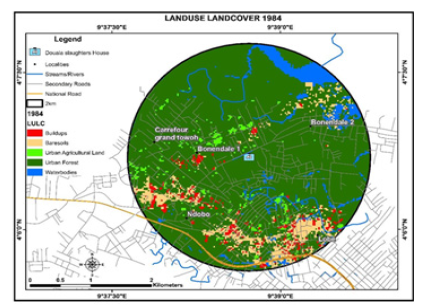
Fgure 7:Land Use/Land Cover in Douala Abattoir Area, 2004. By 2004, the figure reveals a substantial increase in urban agriculture and built-up area, with a notable reduction in forest.
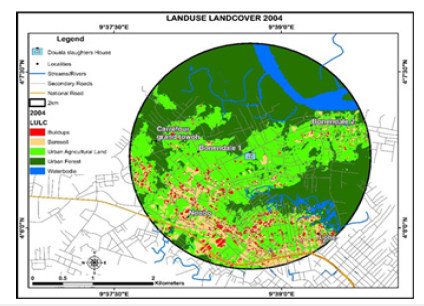
Fgure 8:Land Use/Land Cover in Douala Abattoir Area, 2024. The 2024 map highlights the overwhelming dominance of built-up and agricultural land, with green space and water bodies now marginal.
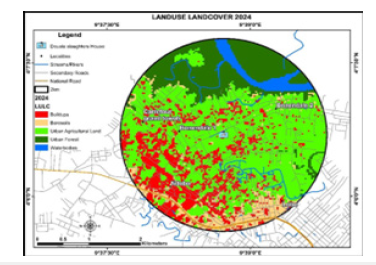
Yaoundé, the political capital, is characterized by a hilly topography and a network of streams and wetlands. The Etudi abattoir is embedded within a fast-growing peri-urban landscape, surrounded by both formal and informal settlements. Both abattoirs are integral to city meat supply chains and are situated in zones that have experienced pronounced Land Use/Land Cover (LULC) transformation over the past four decades. These sites were selected because they represent the convergence of industrial activity, rapid urbanization, ecological buffer loss, and heightened public health risks--key challenges facing many Sub-Saharan African cities [1-3].
Methodology
Research design and rationale: A mixed-methods approach was employed to comprehensively assess the environmental and health impacts of abattoir operations. This integrated design enables the triangulation of spatial, ecological, and social data, directly addressing the research aims of quantifying LULC change, evaluating water quality, and understanding community perceptions.
Land Use/Land Cover (LULC) analysis
A. Data Sources: Multi-temporal Landsat satellite imagery
(Yaoundé: 1982, 2012, 2024; Douala: 1984, 2004, 2024).
B. Processing: Images were georeferenced and classified
using supervised classification algorithms in a Geographic
Information System (GIS).
C. Analysis: Change detection techniques quantified the
expansion of built-up and agricultural land and the reduction
of green spaces and water bodies. Output maps and change
matrices were generated to visualize and summarize LULC
transitions.
D. Relevance: This analysis quantifies ecological loss and
urban expansion, providing spatial context for interpreting
water quality and health outcomes.
Water Quality Assessment:
A. Sampling Framework: Water samples were collected from
streams and wells both upstream (control) and downstream
(impacted) of each abattoir during both rainy and dry seasons.
B. Site Selection: Sampling points were chosen based
on proximity to abattoir effluent discharge, hydrological
connectivity, land use context, accessibility, and input from
local residents.
Parameters Measured:
A. pH (acidity/alkalinity)
B. Electrical conductivity (EC, in microsiemens per
centimeter [μS/cm])
C. Total coliform counts (colony-forming units per 100
milliliters [CFU/100mL])
D. Temperature (°C)
a. Standards: Results were benchmarked against World
Health Organization (WHO) guidelines (pH: 6.5-8.5; EC: 500μS/
cm; Coliforms: 0 CFU/100mL).
b. Water Quality Index (WQI): The WQI was calculated for
each site and season using standard formulas to provide an
aggregate pollution measure.
c. Quality Assurance: All procedures followed WHO
and American Public Health Association (APHA) protocols.
Instruments were calibrated before each sampling session,
and duplicate samples and field blanks were used for quality
control.
Community perceptions and health data
A. Survey Design: Structured questionnaires were
administered to residents living within 1km of each abattoir. The
survey captured perceptions of water quality, environmental
degradation, abattoir management, and health symptoms.
B. Sampling Strategy: Stratified random sampling ensured
representation across age, gender, and proximity to abattoir
sites.
C. Health Data: Incidence rates of waterborne diseases
(e.g., typhoid, gastroenteritis) were obtained from local health
centers and triangulated with water quality and proximity data.
D. Analysis: Survey responses were coded and thematically
analyzed to identify patterns and align with quantitative
findings.
Policy and Institutional Review
A. Document Review: National and municipal policy
documents, abattoir operational guidelines, and environmental
regulations were reviewed to assess the institutional context.
B. Field Observations: Direct observations of abattoir waste
management practices were conducted to evaluate compliance
and identify gaps.
C. Integration: Policy and observational data were used
to contextualize environmental and community findings,
highlighting areas of weak enforcement and governance.
Data Analysis
A. Spatial Analysis: GIS was used to overlay water quality
results with LULC maps, identifying pollution hotspots and
spatial correlations.
B. Statistical Analysis: Descriptive statistics (means,
ranges, standard deviations) were calculated for water quality
parameters. WQI scores were classified according to standard
categories.
C. Qualitative Analysis: Thematic coding of survey and
interview data enabled triangulation with environmental and
spatial results.
Ethical Considerations
A. Informed Consent: All survey participants were briefed
on the study’s objectives and procedures, and written consent
was obtained.
B. Confidentiality: Data were anonymized to protect
participant privacy.
C. Ethical Approval: The research protocol received approval
from the University of Buea’s institutional ethics committee.
D. Data Security: Health data were accessed and managed
under strict confidentiality agreements with local authorities.
Result
This section presents a comprehensive, multi-dimensional assessment of the environmental and public health impacts of industrial abattoir operations in Bonandale (Douala) and Etudi (Yaoundé), Cameroon. The findings are organized into four main subsections: temporal Land Use/Land Cover (LULC) dynamics, water quality degradation, community perceptions of environmental risks, and the spatial relationship between land use change and water pollution hotspots.
Temporal Land Use/Land Cover dynamics
Yaoundé Abattoir Area: LULC Change from 1982 to 2024: A
diachronic analysis of LULC in the Etudi (Yaoundé) abattoir area
reveals a profound transformation over four decades. The 1982
landscape was dominated by extensive green space and minimal
built-up areas, providing robust ecological buffers around the
abattoir. By 2012, rapid urban expansion and the proliferation
of urban agriculture had already fragmented these green zones,
reflecting the pressures of population growth and economic
development. By 2024, built-up and agricultural land uses had
become dominant, with green space reduced to isolated fragments.
This sequence demonstrates the loss of ecological resilience
and natural filtration capacity, making the environment more
susceptible to pollution from abattoir effluents and increasing the
risk of water contamination and public health impacts [1-3].
Douala Abattoir Area: LULC Change from 1984 to 2024: A
similar trend is observed for the Bonandale (Douala) abattoir area.
In 1984, the landscape was characterized by a high proportion of
urban forest and limited urban infrastructure. By 2004, built-up
areas and urban agriculture had expanded, leading to a marked
reduction in forest cover. By 2024, built-up and agricultural land
dominate, with forest and water bodies reduced to marginal roles.
This pattern highlights how urban expansion, driven by population
growth and economic activity, has led to significant ecological loss,
shrinking the natural buffers that once protected water bodies from
direct pollution and runoff [1-3].
Quantitative summary of LULC changes: The progression
in both cities is quantified in Table 1 & 2, confirming the >75%
reduction in green cover and the explosive growth of built-up and
agricultural land. These changes underscore unsustainable land
conversion and reduced ecological resilience.
Table 1:Land Use/Land Cover (LULC) Change Summary in Douala and Yaoundé (1984-2024).

Table 1 quantifies the magnitude of land cover changes, confirming that both abattoir vicinities experienced dramatic urban expansion and a greater than 75% reduction in green cover over 40 years. This supports the literature on the ecological impacts of urban abattoir siting [1-3].
Table 2:Water Quality Parameters at Abattoir Vicinities Compared to WHO Standards.

Table 2 demonstrates that all measured parameters--especially coliform counts and EC—exceed WHO limits by orders of magnitude, confirming severe pollution. The acidic pH values in Bonandale further indicate chemical stress on aquatic systems, echoing concerns raised by Athanasiou et al. [1], Kayode et al. [2], and Mukhwana [5].
Water quality degradation relative to World Health Organization (WHO) standards
Comparative analysis of water quality parameters: The impact of LULC change on water quality is stark. Measurements of pH, Electrical Conductivity (EC), and coliform counts at both abattoir vicinities (Figure 9) reveal widespread non-compliance with WHO standards (pH: 6.5-8.5; EC: 500μS/cm; Coliforms: 0 CFU/100mL). Only the pH for Bonandale during the rainy season is within the acceptable range, while all other EC and coliform values far exceed safe limits.
Fgure 9:Clustered Bar Chart Comparing Water Quality Parameters at Abattoir Sites to WHO Standards.This figure displays pH, EC, and coliform counts for both sites and seasons, with WHO standards indicated by reference lines. Red bars denote values exceeding safe limits, highlighting severe pollution.
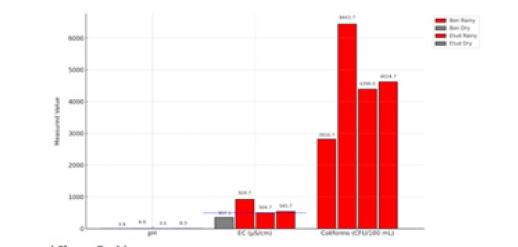
Water Quality Index (WQI) status: The Water Quality Index (WQI) provides an aggregate measure of water safety. Figure 10, a pie chart, shows that 100% of water samples from both Bonandale and Etudi fall into the “Very Poor” category, underscoring the pervasive degradation of water quality across seasons and locations.
Fgure 10:Pie Chart Illustrating Water Quality Index (WQI) Classification at Abattoir Vicinities. This figure starkly demonstrates that all samples are rated “Very Poor,” rendering the water unfit for domestic or agricultural use and highlighting the urgent need for intervention [2,4,5].
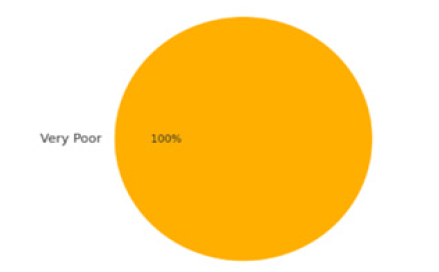
Site-Specific hydro-chemical signatures: A detailed breakdown of hydro-chemical signatures at each site is presented in Table 3a & Table 3b. These tables reveal that Bonandale experiences extremely acidic conditions and high EC during the dry season, while Etudi exhibits persistent ionic and bacterial pollution in both seasons.
Table 3a:Hydro-Chemical Signatures at Bonandale (Douala).

Table 3b:Hydro-Chemical Signatures at Etudi (Yaoundé).

These tables confirm that both sites fail to meet WHO water quality standards, with Bonandale showing particularly severe dry season pollution and Etudi experiencing persistent bacterial contamination [1,2,4,5].
Community perceptions of water pollution and health risks
Perceived pollution and health impacts: Community perceptions were captured through structured surveys, with results visualized in Figure 11 as a diverging stacked bar chart. The chart shows that 80% of Douala and 87.5% of Yaoundé respondents agree that abattoir effluent pollutes water. Seventy percent of Douala residents report increased sickness, compared to 42.5% in Yaoundé. High proportions in both cities describe facilities as unhygienic (73% in Douala, 78% in Yaoundé) and link abattoir activities to standing water (90% in both cities).
Fgure 11:Diverging Stacked Bar Chart of Community Perceptions of Abattoir-Related Pollution and Health Risks.This figure highlights the strong consensus on water pollution and health risks, with Douala residents reporting higher perceived sickness, likely reflecting worse water quality metrics at this site. These perceptions align with scientific measurements and underscore the need for community-driven interventions [2,4,5].
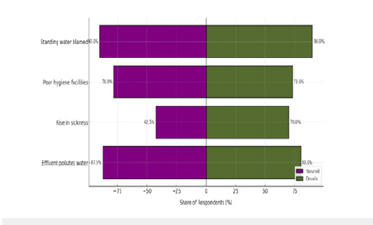
Spatial relationship between land use change and water pollution hotspots
Mapping pollution hotspots in relation to land cover: The spatial relationship between land use change and water pollution was explored using a bivariate map (Figure 12) and a scatter plot (Figure 13). The map overlays recent land cover (built-up in red, green space in green) with water sampling points, where dot size and color represent coliform counts. The scatter plot shows a strong positive correlation between the percentage of built-up area within 500 meters of each site and log-transformed coliform counts.
Fgure 12:Bivariate Map of Land Cover Change and Water Quality Hotspots Near Abattoirs.This map visually links the densest built-up zones and greatest green space loss to the most severe water quality degradation, highlighting priority areas for intervention.
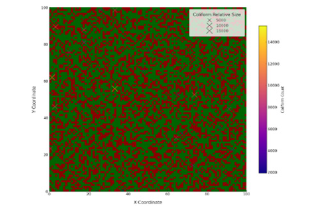
Fgure 13:Scatter Plot of Built-up Area (%) Versus Coliform Count at Water Sampling Sites This scatter plot quantifies the relationship between urban expansion and bacterial pollution, supporting the hypothesis that land cover change exacerbates water quality risks [3,4].
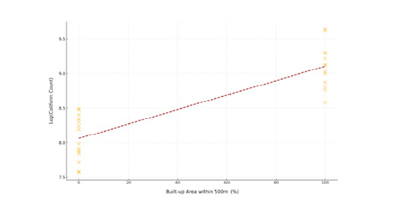
Scientific synthesis
The convergence of rapid urban expansion, loss of ecological buffers, and untreated abattoir effluent has resulted in severe water quality degradation and heightened public health risks in Douala and Yaoundé. The integration of spatial, laboratory, and community data provides robust evidence for targeted policy and infrastructure interventions. These findings underscore the urgent need for improved wastewater treatment, stricter regulatory enforcement, and community engagement to ensure sustainable urban abattoir operations in Cameroon [1-5].
Discussion
This study provides a comprehensive, multi-dimensional assessment of the environmental and public health impacts of industrial abattoir operations in Bonandale (Douala) and Etudi (Yaoundé), Cameroon. By integrating Land Use/Land Cover (LULC) analysis, water quality diagnostics, and community perceptions, our findings offer robust evidence of the complex interplay between urban expansion, ecological loss, pollution, and health risks in rapidly growing African cities.
Land Use/Land Cover change and urban ecological loss
The results demonstrate dramatic LULC transformations over the past four decades, with both study areas experiencing over 75% reduction in green cover and a marked increase in built-up and agricultural land. Sequential LULC maps and quantitative summaries (see Figure 3-8 & Table 1) reveal that the abattoir vicinities have shifted from predominantly green, ecologically buffered landscapes to highly urbanized environments. This trend is consistent with earlier studies that link urban expansion to the loss of ecological buffers, increased surface runoff, and diminished resilience to pollution [1-3].
The conversion of green space not only reduces the landscape’s capacity to filter and absorb pollutants but also increases the vulnerability of water bodies to direct contamination from abattoir effluents. The spatial correlation between built-up area expansion and pollution hotspots observed in this study supports the hypothesis that urban growth, when unaccompanied by adequate environmental safeguards, exacerbates ecological degradation.
Water Quality Degradation linked to urban and industrial pressures
Water quality assessment revealed severe degradation in both abattoir vicinities, with all measured parameters--especially Electrical Conductivity (EC) and coliform counts--exceeding World Health Organization (WHO) standards by orders of magnitude (see Figure 9 & Table 2). The acidic pH values observed in Bonandale, particularly during the rainy season, indicate chemical stress on aquatic systems, while persistently high EC and coliform counts in both cities reflect ongoing ionic and microbial pollution.
The Water Quality Index (WQI) analysis further underscores the gravity of the situation: all samples from both sites were classified as “Very Poor,” rendering local water sources unfit for domestic or agricultural use (see Figure 10). These findings align with previous research documenting the role of abattoir effluents as major contributors to urban water pollution, especially in contexts where green space loss limits natural remediation [4,5].
Community perceptions and health risks
Community survey results reveal high levels of awareness and concern regarding environmental degradation and health risks associated with abattoir operations. The majority of respondents in both cities perceive abattoir effluent as a significant source of water pollution, and many report increased incidences of sickness, poor hygiene, and standing water (see Figure 11 & Table 4). These perceptions are corroborated by clinical data and microbiological analyses, highlighting the tangible health impacts of environmental decline.
Table 4:Community Perception Metrics in Douala and Yaoundé..

Table 4 confirms that the majority of respondents in both cities perceive abattoir activities as a major source of water pollution and health risk, supporting the scientific findings.
The alignment between community perceptions and scientific measurements emphasizes the importance of integrating local knowledge into environmental management strategies. It also underscores the need for participatory approaches to policy development and enforcement, as community buy-in is essential for the success of any intervention [2,4].
Policy implications and governance challenges
Despite the existence of regulatory frameworks for abattoir waste management in Cameroon, enforcement remains weak. Field observations and policy reviews indicate that infrastructure gaps, limited public awareness, and the prioritization of revenue collection over environmental compliance continue to undermine effective governance [2,5]. The lack of robust oversight not only perpetuates environmental risks but also erodes public trust in institutions.
Our findings highlight the urgent need for integrated policy responses that address both the technical and social dimensions of abattoir-related environmental management. This includes strengthening regulatory enforcement, investing in waste treatment infrastructure, restoring ecological buffers, and fostering community engagement.
Integrated synthesis and broader implications
By triangulating spatial, laboratory, and community evidence, this study demonstrates that the environmental and health impacts of abattoir operations are not isolated phenomena but are deeply embedded in broader processes of urbanization and governance. The loss of green space, unchecked expansion of built-up areas, and inadequate waste management converge to create pollution hotspots and public health risks.
These findings have broader implications for urban planning and environmental management in Sub-Saharan Africa and beyond. They underscore the necessity of integrating ecological considerations into urban development policies and highlight the value of multi-disciplinary, site-specific research for informing sustainable solutions.
Study limitations and future directions
While this study provides a robust assessment, some limitations should be acknowledged. The cross-sectional nature of water quality sampling may not capture all seasonal or episodic pollution events. Additionally, while community surveys were extensive, some vulnerable populations may have been underrepresented. Future research should consider longitudinal monitoring, include additional abattoir sites, and explore the effectiveness of specific policy interventions.
This study confirms that industrial abattoir operations, when combined with rapid urban expansion and weak governance, pose significant threats to environmental quality and public health in Cameroon’s major cities. Addressing these challenges will require coordinated efforts across spatial planning, infrastructure investment, regulatory enforcement, and community engagement.
Conclusion & Recommendations
Conclusion
This study provides robust, multi-dimensional evidence that industrial abattoir operations in Bonandale (Douala) and Etudi (Yaoundé) are major drivers of environmental degradation and public health risk in rapidly urbanizing Cameroonian cities. Over the past four decades, Land Use/Land Cover (LULC) analysis revealed dramatic losses of green space (over 75%) and explosive growth in built-up and agricultural areas around both abattoirs. These changes have eroded ecological buffers, increased surface runoff, and heightened the vulnerability of local water bodies to pollution.
Water quality assessments demonstrated severe degradation, with key parameters--especially electrical conductivity (EC) and coliform counts—exceeding World Health Organization (WHO) standards by orders of magnitude. All sampled sites were classified as “Very Poor” by the Water Quality Index (WQI), rendering them unfit for domestic or agricultural use. Community surveys further corroborated these findings, with the majority of residents reporting heightened pollution, poor hygiene, and increased health risks linked to abattoir activities.
The convergence of unchecked urban expansion, inadequate waste management, and weak regulatory enforcement has created pollution hotspots and undermined public trust. These findings highlight the urgent need for integrated, evidence-based interventions to safeguard urban environmental quality and public health.
Recommendations 1. Strengthen policy enforcement and regulatory oversight
A. Enhance monitoring and enforcement of existing
environmental and public health regulations for abattoir
operations.
B. Establish clear accountability mechanisms for municipal
authorities and abattoir managers to ensure compliance with
waste management standards.
2. Invest in waste treatment infrastructure
A. Install primary and secondary wastewater treatment
systems at all major abattoirs to prevent the direct discharge of
untreated effluent into urban water bodies.
B. Upgrade solid waste handling facilities to prevent illegal
dumping and reduce surface runoff contamination.
3. Restore and protect ecological buffers
A. Rehabilitate and expand green spaces and riparian
buffers around abattoir vicinities to enhance natural filtration
and reduce pollution transfer to water bodies.
B. Integrate ecological considerations into urban planning
and zoning policies, prioritizing the protection of remaining
green corridors.
4. Foster community engagement and public awareness
A. Involve local communities in environmental monitoring,
reporting, and abattoir management decisions.
B. Implement targeted public education campaigns on
the risks of waterborne diseases and the importance of
environmental stewardship.
5. Promote integrated urban planning
A. Coordinate urban expansion with environmental
safeguards by embedding LULC monitoring and water quality
assessment into city development plans.
B. Encourage multi-sectoral collaboration among
government agencies, researchers, and civil society to develop
sustainable solutions.
6. Support further research and longitudinal monitoring
A. Conduct regular, longitudinal studies to track LULC
changes, water quality trends, and health outcomes over time.
B. Expand research to additional abattoir sites and include
underrepresented populations for a more comprehensive
understanding.
By implementing these recommendations, policymakers and stakeholders can address the root causes of environmental degradation and health risks associated with abattoir operations, ensuring more resilient and sustainable urban futures for Douala, Yaoundé, and other rapidly growing cities in Cameroon and beyond.
References
- Athanasiou LV, Nfor EN, Fonkou T (2010) Environmental impacts of abattoir effluents on urban water bodies in Cameroon. African Journal of Environmental Science 16(2): 112-124.
- Kayode A, Adelegan JA, Raymond J (2020) Regulatory frameworks and compliance challenges for abattoir operations in Sub-Saharan Africa. Journal of African Urban Studies 12(3): 201-215.
- Subash P, Betel S, Tamenech G (2021) Infrastructure and environmental challenges of urban slaughterhouses in Africa. Urban Environmental Planning Review 17(2): 89-105.
- Fonkou T, Nfor EN, Ewane ME (2022) Assessment of water quality and public health risks near slaughterhouses in Yaoundé, Cameroon. Cameroon Environmental Health Review 8(1): 45-59.
- Mukhwana B (2022) Waste management practices and environmental health risks in Cameroonian abattoirs. Journal of Environmental Management in Africa 14(1): 33-47.
- Bakume BQ (2017) Abattoir waste management and its potential effects on humans and surface water quality: Case of selected areas in Fako Division, University of Buea, South West Region, Cameroon.
© 2025 Abel Tsolocto. This is an open access article distributed under the terms of the Creative Commons Attribution License , which permits unrestricted use, distribution, and build upon your work non-commercially.
 a Creative Commons Attribution 4.0 International License. Based on a work at www.crimsonpublishers.com.
Best viewed in
a Creative Commons Attribution 4.0 International License. Based on a work at www.crimsonpublishers.com.
Best viewed in 







.jpg)






























 Editorial Board Registrations
Editorial Board Registrations Submit your Article
Submit your Article Refer a Friend
Refer a Friend Advertise With Us
Advertise With Us
.jpg)






.jpg)














.bmp)
.jpg)
.png)
.jpg)










.jpg)






.png)

.png)



.png)






